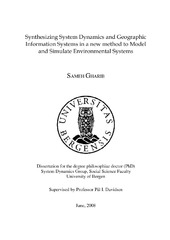Synthesizing System Dynamics and Geographic Information Systems in a new method to Model and Simulate Environmental Systems
Doctoral thesis
Permanent lenke
https://hdl.handle.net/1956/3296Utgivelsesdato
2008-12-12Metadata
Vis full innførselSamlinger
- Department of Geography [634]
Sammendrag
A new method to synthesize system dynamics (SD) with geographicinformation systems (GIS) is presented in this research. This new method employsthe Object Oriented Paradigm (OOP) as a common platform for the integrationprocess. Recently, GIS software such as ArcGIS has become fully Object-Orientedsoftware, providing the ArcObjects developer kit as a collection of (COM-compliant)objects that can be linked/embedded within other OO software. Vensim® software isan Object-Based simulation environment that can be used to build simulation modelsthat may be linked to other applications through its dynamic link library (DLL). Wedeveloped a new application, referred to as SDGIS Application, using MicrosoftVisual Basic to tightly couple the SD model components with their counterparts inthe GIS model (i.e., stocks and flows with the associated geo-referenced features).Initially, the GIS model provides the spatial information to the SD model. TheSD model, through simulation, identifies the changes in the spatial features over timeand communicates them back to the GIS model. These changes in space in turnimpact the decisions taken by the user. Thus, processes can be modelled in time andspace in an integrated way while capturing underlying accumulation process, thefeedbacks, and nonlinearities.The underlying approach, resulting in creation of the SDGIS application,provides a much-needed capability to model spatially distributed, dynamic feedbackprocesses in time and space, while facilitating an understanding of the interactionsbetween different components within the system. The main strength of this approachis the two-way simultaneous exchange of data between the SD and GIS, providingfeedback in time and space. The technique used to build the SDGIS application isdifferent than existing techniques for dynamic modelling such as Cellular Automata;Agent-Based simulation and GIS Model-Builder, and addresses most of thelimitations present in these techniques. This approach, and the associated techniques,can be used to build similar applications like the SDGIS to model a variety of naturaland social processes where the main concern is the space–time interaction. This istrue in cases that concern environmental processes, water and/or natural resourcesmanagement, and disaster management. In this research, the applicability of theSDGIS Application is demonstrated with an application to the irrigation system in theNile Delta region in Egypt.
Utgiver
The University of BergenBeslektede innførsler
Viser innførsler beslektet ved tittel, forfatter og emneord.
-
Food provision and environmental goals in the Swiss agri-food system: System dynamics and the social-ecological systems framework
Kopainsky, Birgit; Huber, Robert; Pedercini, Matteo (Peer reviewed; Journal article, 2015-07)An important challenge for the Swiss agri-food system is how to align food provision with environmental goals in the context of increasingly complex conditions. This paper describes a system dynamics model that analyses ... -
Systems Engineering Applied to Evaluate Social Systems: Analyzing systemic challenges to the Norwegian welfare state
Palmer, Erika (Doctoral thesis, 2017-12-01)The Norwegian welfare state is one of the most generous in the world providing social security through universal healthcare, education and childcare. Elderly Norwegians also face a relatively secure retirement with a solid ... -
Understanding resilience of farming systems: Insights from system dynamics modelling for an arable farming system in the Netherlands
Herrera, Hugo; Schütz, Lilli; Paas, Wim; Reidsma, Pytrik; Kopainsky, Birgit (Journal article; Peer reviewed, 2022)Farming systems in Europe are facing economic, social, environmental and institutional challenges. Highly intensive, climate-exposed, arable farming systems like the Veenkoloniën in the north of the Netherlands are ...
